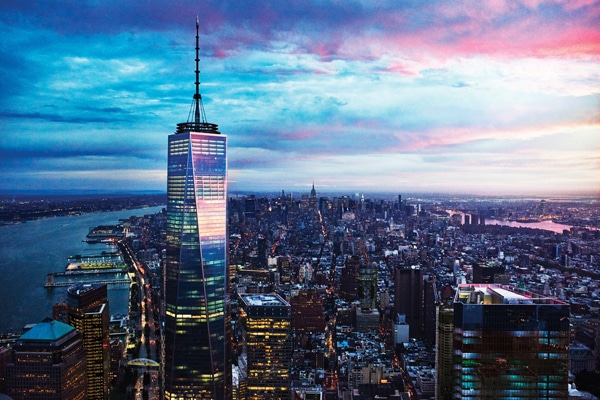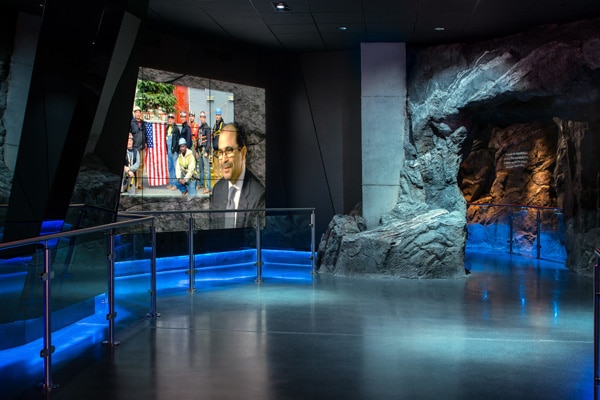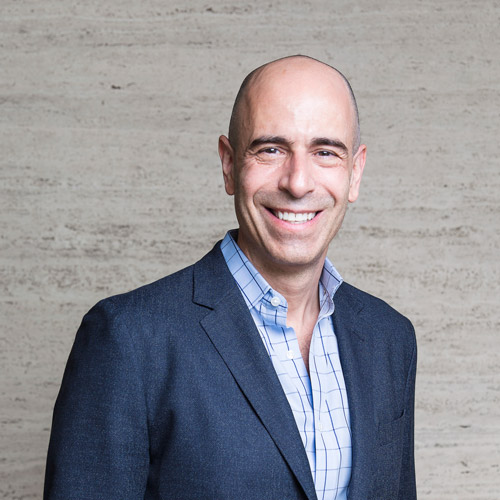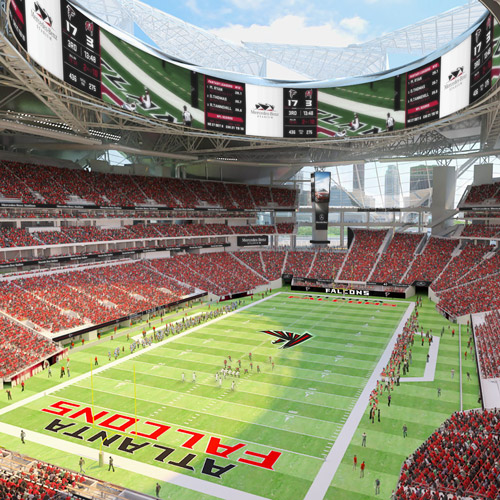One World Trade Center in New York City represents a new way forward for many. Not least of which is Legends, a turnkey service provider that’s partner to many of the most well-known sports franchises and universities around the world. With the development of One World Observatory atop the tallest building in the Western Hemisphere, Legends entered the attractions realm in one of the most visible and emotionally stirring projects of the century.
American Builders Quarterly spoke with Francis Coiro, vice president of project management, and John Urban, vice president and general manager of Legends Attractions, about the construction and completion of the observatory.
What would you say was the biggest challenge that you faced in the construction and/or completion of the One World Observatory?
Coiro: I think the key was understanding the way the Port Authority was managing the overall project site in terms of how they wanted to secure it. You were not allowed to work here unless you had a complete background check. Everybody had to take training just to understand the ways and operations of the site. They expected exemplary behavior.
The second challenge was more physical—we were building our space out while the Port Authority was still doing general construction on the building. Depending on what week we were in, that changed access points. We were lucky because we were able to use our own dedicated elevators, but there were operational issues just the same. There were timing issues that meant we rerouted or redirected the way we took materials through the building. One day, it could be a five-minute delivery, the next day it could be a 50-minute delivery.
Urban: Imagine you’re playing chess on two very different boards. One was the completion of the tower itself, and one was the schedule and push that we were making on our piece of that overall project. Fran’s being very humble in relaying just how critical and how delicate that balance was—literally from one day to the next. The tower was getting built and fitted out, we were building and fitting out the observatory space, and it was all happening on this very finite formula of vertical transportation. Lay that on top of the security considerations that come into play just because of where the site is and what the site is. The project is a credit to the entire team, the best in the business. The professionals who really, really knew what it took—scheduling-wise and coordination-wise, every day—will have that as a career highlight; that they were able to thread that needle so effectively.

What was the most pleasant surprise of the project?
Coiro: It was satisfying to see everyone agree with our view toward how special the build was—not just the view, but the elements we put into it. Some things get rote as you’re punch-listing them. It’s not that the space ever gets tired, but it was nice to get fresh sets of eyes and positive reactions and excitement from everybody that came here. It was very rewarding to go through that process and know that we had done the right thing.
Urban: The intent here—which came right from the start with the original members of the design, construction, and creative teams—was, “We’re going for it.” For folks like JRM Construction, the Hettema Group, MADGI, AMA, and so many others—including on the Legends side—this simply was not going to be your standard “elevator ride to the windows” kind of observatory. It demanded more than that in terms of what the experience was going to be.
As Fran said, there’s an interesting point in a project where the team is so sequestered with planning, ongoing meetings, development, and so forth that you might think that what’s coming to life in front of you in conference rooms is pretty cool, but you don’t know until it actually gets out there and gets that validation. Fran used the right word—it was rewarding for everyone.

Given the history of the site and that it’s on such a large worldwide stage, was there any point during the project that you felt overwhelmed?
Coiro: Overwhelmed, no. If there was any point where the importance of the project became evident, I would say it was as we started to finish it and the buzz started to go around. There was this point where you said, “We did it. People are really looking at this. They’re looking beyond what happened on the site. There’s a new feel about what One World Observatory is doing to One World Trade.” When the chief of the fire department is proud of what he sees relative to the losses from 15 years before, that’s a special moment, you know?
Urban: Certainly, by every measure as a construction endeavor in this city on that site, it was epic. Every member of the team felt genuinely privileged to be part of it.
At certain times in the project, there might have been opportunities to go another direction that would’ve been less stressful, but everyone around the table challenged themselves. In that sense, there was a pride everyone had and responsibility they felt because it was One World Trade Center. Let’s face it—there are people drawn to projects like that because they want to deliver something big. Not coming from a design and construction background myself, I will forever be in awe of that level of skill and expertise.

Legends Hospitality is responsible for some of the most well-recognized locations around the world. How would you say One World Observatory compares to other projects in the company’s portfolio?
Urban: It’s hard to compare them head-to-head. When we talk about other venues that we operate in, we have a very specific role—say, at Yankee Stadium or AT&T Stadium—where we might be delivering top-shelf hospitality or exciting retail or premium sales results. What was so unique about One World Observatory was that this was a project where we were designing, building out, and bringing to life—from a construction and business standpoint—everything. Often, we’re going into existing operations and being asked to take something up a notch or deliver our expertise in a particular niche on a new project. At One World, we were on the front lines to conceive, design, build, construct, hire, operate, brand, sell, market, and so on. It was a true 360-degree effort.
Winning the [request for proposals] for One World was Legends’ entrée into the attractions business. It created an entirely new vertical for the company.

From a construction and development standpoint, what’s one aspect of the project that maybe the general public might not know about on first look?
Coiro: During development, people would come up and sign the concrete walls. Some people signed their name and dated it, some people wrote a message. It was very poignant. Carpenters had to cover up the walls where, in a few cases, it had been signed by Congressional Medal of Honor winners. The best part about it was the carpenters would frame around a Congressional Medal of Honor winner’s name because they refused to drive a stud through the name or the signature. To me, that just speaks volumes to what the space is about: the honor that we were expected to extend on this job site, the honor extended by the people working on the job site, and the subtle little things that make this a special space.
Urban: There are thousands of signatures that are preserved there forever behind the sheetrock and fit out. Every floor. It’s anybody and everybody that had the privilege of working on or visiting the site during construction—with the widest range of emotional and poignant messages—including President and Mrs. Obama. It’s hard not to be struck by how powerful that really is.
How did development of the observatory fit into the construction of the building at large?
Coiro: The building was still under construction and we were at the top of the building, so that’s the last space to be completed. During construction, they would change things, so when we got to work on our space, there were things that were not in the drawings. There were banks of conduits that were there that weren’t supposed to be there. There were floor openings that weren’t supposed to be there that were there. There were floor openings that were supposed to be there that weren’t there. We would have to change a ceiling design, change a lighting design, change an access point, add an access point. There was set steel that they put in, and when they were done, they just left it there, welded in place. We would say, “You have to come and burn that stuff out.” It made for some interesting conflicts. Some good things were caught. We were able to catch things early enough to correct it.
The reason we’re sitting here with a good story is because we had the constant interface and support of our partners at the Port Authority and [developer] The Durst Organization. The three entities worked together, as we did with Tishman Construction, the overall building contractor. In the end, every meeting was about solving a problem, communicating. There could’ve been some tough chapters in this story, but early on we knew what the expectations were, and we met those expectations.


